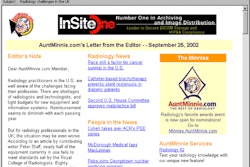Business managers have the greatest stake in complying with U.S. fraud and abuse regulations, because they’re the ones at whom all fingers will point if there’s ever an investigation. And, as radiology gets a greater percentage of the U.S. federal healthcare dollar, the specialty's billing and coding practices are coming under greater scrutiny.
During the Clinton administration, U.S. Attorney General Janet Reno made the investigation of healthcare fraud and abuse a top priority of the U.S. Department of Justice (DOJ). And while the war on terrorism and recent acts of corporate accounting malfeasance are consuming resources of investigative agencies, there are still plenty of DOJ agents targeting healthcare fraud and abuse.
"The FBI, even though some agents have been pulled off to assume anti-terrorist duties, still has agents out there who are specifically tasked with investigating fraud and abuse," said attorney Alice Gosfield of Alice Gosfield & Associates in Philadelphia.
Gosfield presented her take on some of the hottest issues in fraud, abuse, and reimbursement at the 2002 Radiology Business Management Association Summit in Naples, FL. Her advice to the attendees was to be careful and diligent in their coding practices.
"At $10,000 per claim plus triple the charges in damages, penalties can quickly add up to overwhelming sums. For example, a recent case of $130,000 in false charges resulted in $18.8 million in damages awarded. The award was reduced on appeal, but it was still a substantial amount for the defendant," she noted.
As no proof of specific intent is required for a successful prosecution on the fraud and abuse regulations, radiology administrators must exercise careful diligence when coding procedures at their facilities. There are a couple of areas Gosfield mentioned to which radiology managers should pay close attention.
Muddling through mammograms
Part 42 of the Code of Federal Regulations, 410.32 (42 CFR 410.32) specifies: "All diagnostic tests must be ordered by the physician who is treating the beneficiary." It seems straightforward enough; however, there is an exception for mammography.
"A physician who meets the qualification requirements for an interpreting physician under section 354 of the Public Health Service Act as provided in Sec. 410.34(a)(7) may order a diagnostic mammogram based on the findings of a screening mammogram even though the physician does not treat the beneficiary."
What happens if the radiologist reading the exam wants to order and bill additional diagnostic tests? Here, according to Gosfield’s February 27, 2002 correspondence with the Centers for Medicare and Medicaid Services (CMS), the coding waters become increasingly murky.
"(Rule) 42 CFR 410.32, as implemented by section 15021 of the Medicare Carriers Manual (MCM), applies to diagnostic tests furnished to a beneficiary who is neither a hospital inpatient nor outpatient. Therefore, regardless of the location of the testing, the interpreting radiologist may order additional or new tests only if the beneficiary is a hospital inpatient or outpatient. If the beneficiary is neither a hospital inpatient nor outpatient, then the radiologist must comply with MCM 15021," wrote Paul Kim of the division of practitioner and ambulatory care, provider purchasing group, at the CMS’ Center for Medicare Management.
However, if the patient self-refers to an imaging center or radiology group for a screening mammogram, the circumstances for ordering and billing additional testing change.
"The interpreting radiologists may order additional or new medically necessary tests because the radiologist is considered the patient’s treating physician in patient self-referral situations," Kim wrote.
Billing gymnastics
Splitting the billing of the professional component and technical component when services are performed on different days is something else radiology managers should keep an eye on, Gosfield noted.
"If the technical component is done on one day, and a report is done on another day, or if they are furnished in different locations, it will be necessary to submit separate line items for each component of the service. Global billing is appropriate only when all components of the service are furnished by the same provider, on the same date, and at the same physical location," she said.
A radiology group that owns its equipment and employs its own personnel, but is providing inpatient service to a hospital, cannot bill CMS for the technical component. This part of the bill is viewed by CMS as a service for which the hospital must be billed, not the group.
"In fact, attempts by physicians to unbundle and bill services deemed to be part of hospital services to a patient can entail a civil money penalty liability," Gosfield said.
Coding caveats
Gosfield recommends that if there are ever any questions about the appropriateness of a billing code, that radiology administrators contact their facility’s healthcare attorney for guidance.
"Don’t ever call the carrier with ‘how-to’ billing questions. One, they don’t know what they’re doing, and two, if you call three times, you’ll get three different answers," Gosfield said.
Consulting an attorney about a billing problem provides a practice with attorney-client privilege, a safety factor that should not be underestimated given the zealousness of U.S. government attorneys.
"There are a couple rules I’ve come up with for billing questions that I share with my clients," she said. "The first is, would you be OK seeing this on the front page of the paper? The second is, if you told your mother what you were doing, what would she say?"
By Jonathan S. Batchelor
AuntMinnie.com staff writer
July 17, 2002
Related Reading
Compliance program essential for reducing fraud and abuse liability, June 6, 2001
OIG audits are scary but survivable, September 22, 2000
U.S. fraud and abuse rules create a minefield for imaging vendors, August 31, 2000
Copyright © 2002 AuntMinnie.com



















